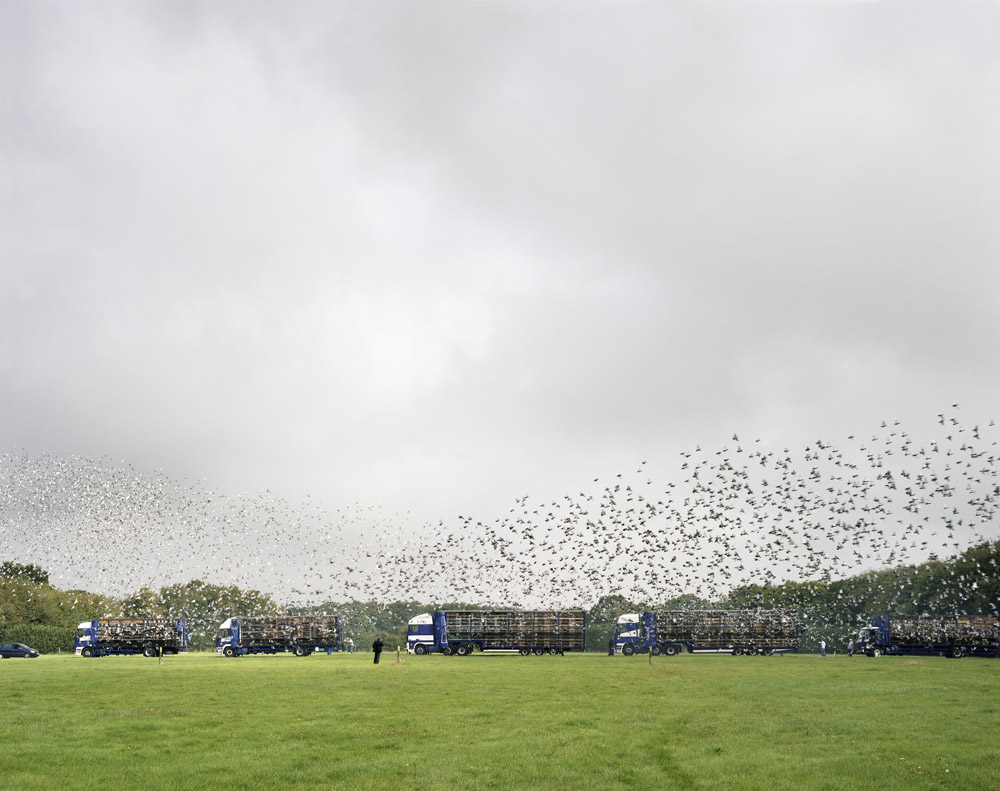 Maidstone Young Bird National Pigeon Race, Maidstone, Kent, 13th September 2008 © Simon Roberts/We English
Maidstone Young Bird National Pigeon Race, Maidstone, Kent, 13th September 2008 © Simon Roberts/We English
The time has come for me to hang up the We English blog and move on to pastures new. I will periodically be updating the site with details of upcoming exhibitions, talks and events and you can follow my future projects over on my homepage here. The first of which will be The Election Project, where I will be documenting the British general election as the official Election Artist for the House of Commons. Why not get involved!
Thanks for joining me during the making of the work, I appreciate your collaboration and comments.
I’ll leave you with links to a few useful resources:
Download my commentary from We English here or read an illustrated version on the blog here.
Download Professor Stephen Daniel’s essay from We English (The English Outdoors, May 2009) here.
Download a pdf of reviews of We English here.
Download a pdf of all the ideas that were submitted by the general public here or read them online here.
Read the headlines from local newspapers that I collected during the We English journey here.
Watch a video interview on Lens Culture where I talk about my approach to making We English here.
Find out more about the limited edition boxset of We English here.
And there is plenty more information about We English over on the National Media Museum’s website, including several podcasts, here.
Posted in INSPIRATION, MISCELLANEOUS | 8 Comments »
My We English blog is coming to an end. Since its inception two years ago, and 333 posts later, the aim is that it’s become a kind of archive, a diary, tracing its own trail of ideas, debates, questions and insights. I hope you’ve enjoyed it!
I’ll leave you with links to a selection of the more informative blog entries, alongside some of my favourites, posted since April 2008 (in chronological order):
Ebony 45S (April 8th 2008)
Tony Ray-Jones (April 16th 2008)
A Page From My Scrap and Some More Pages From My Scrapbook (April 30th 2008)
Not In My Backyard (May 21st 2008)
The Art of Leisure (June 6th 2008)
The Turner Effect (June 27th 2008)
Landscape As Contested Place (June 30th 2008)
The Breakfast Routine (July 21st 2008)
Blackpool & The Humble Postcard (July 26th 2008)
One Man’s Leisure, Another Man’s Work (August 18th 2008)
Daddy, That Man’s Naked! (August 26th 2008)
Editing (September 30th 2008)
The Photographer Photographed (October 24th 2008)
Whose Idea? (October 31st 2008)
Underwhelmed By Parr (November 3rd 2008)
Easy Rider Series (Various Dates)
Contested Countryside (January 16th 2009)
1500-250-80 (March 12th 2009)
This Meagre Nature – Romanticism vs Beauty (March 19th 2009)
John Angerson Interview (May 26th 2009)
The Verona Diaries (Various Dates)
Butlins Reborn (August 19th 2009)
We English & The Big Book Of Breasts (October 27th 2009)
Posted in MISCELLANEOUS | Comments Off on LOOKING BACK
The current edition of archive (March 2010 issue/ Volume 17), the quarterly publication by the National Media Museum, contains ‘In Conversation’ between myself, Professor Stephen Daniels from Nottingham University and Ruth Kitchin, Assistant Curator of Photographs, discussing We English in conjunction with photographs from the Museum’s Collection. The article is published in conjunction with the launch of my exhibitionat the Museum, alongside which we are exhibiting photographs from the National Media Museum’s Collection by a range of 19 th and 20th century photographers who have also been inspired to capture people and place. You can download a pdf of the article here.
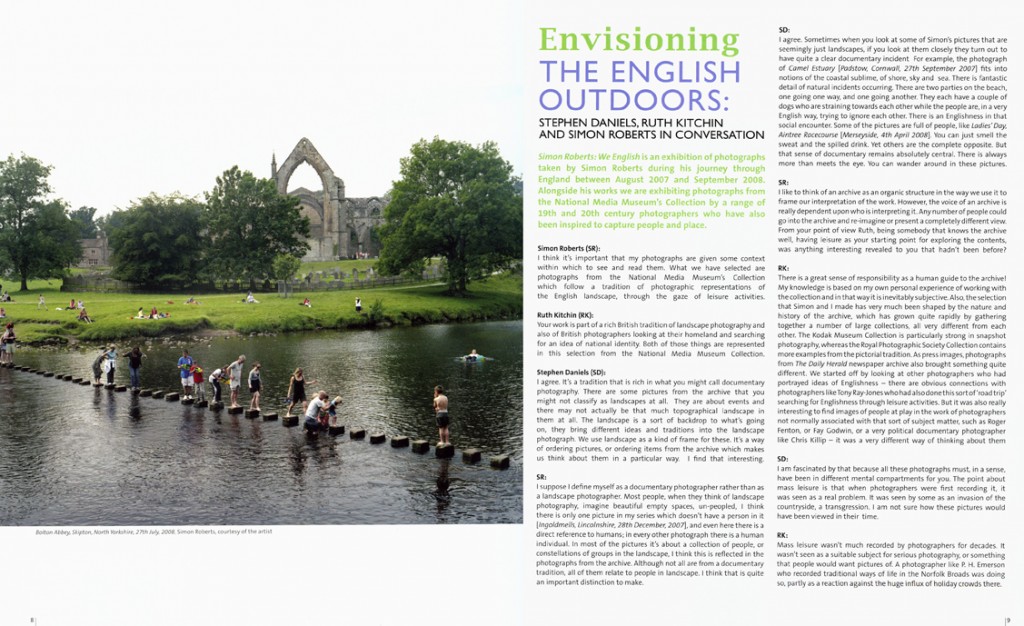
Posted in EXHIBITIONS, INSPIRATION | Comments Off on ENVISIONING THE OUTDOORS
Since it’s release in October 2009 there have been several reviews of We English. Here is a bibliography of the views to date with links to the associated websites or a pdf to download. This list will be periodically updated:
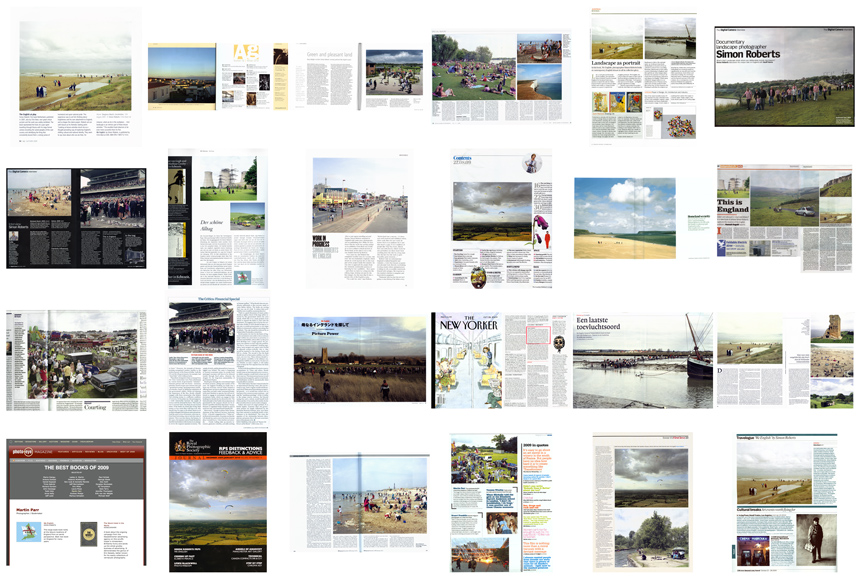
We English reviews & press-
The Saturday Telegraph, “Voyage in search of England,” March 06 2010, Davies, Lucy. (online)
Source, “Away from the shopping centre,†Winter 2009/2010 – Issue 61, Fletcher, Jane. (pdf)
Photo-Eye Magazine, “We English Book Review,†January 18 2010, Bradley, Sarah. (online | pdf)
Ag – The International Journal of Photographic Art & Practice, “Green and pleasant land,†Issue 58/Winter 2010, Badger, Gerry. (pdf)
Visura Magazine, “We English: Simon Roberts,†Issue 07/Spring 2010. (online | pdf)
Photo-Eye Magazine, “The Best Books of 2009,†(We English selected), December 31 2009. (online | pdf)
The Telegraph, “Photographer Q&A with Simon Roberts,†January 07 2010, Davies, Lucy. (online | pdf)
Lens Culture, “Photography as Visual Anthropology in Russia and England,†(video interview), 30th December 2009. (online | pdf)
The Guardian, “Something old, something new: the year’s best photography books,†December 28 2009, O’Hagan, Sean. (online | pdf)
The Sunday Telegraph, “Pictures of the Year: The Photographers’ Choice,†December 27 2009, Parr, Martin. (online | pdf)
The Arts Desk, “Photography 2009: Favourite Books,†December 23 2009, Steward, Sue. (online | pdf)
The Wall Street Journal, “Lenses on the World,†December 12 2009, Woodward, Richard. (online | pdf)
The Guardian, “Christmas Roundup: Photography Books,†December 12 2009, Hone, Prudence. (pdf)
New Statesman, “Picture Book of The Week – We English,†December 07 2009, McClelland, Rebecca. (pdf)
Digital Camera, “Documentary landscape photographer Simon Roberts,†December 2009, Harris, Geoff. (pdf)
Professional Photographer, “We English at South Hill Park,†December 2009. (pdf)
GUP – Guide to Unique Photography, “A Growing Optimism,†022: The Russia Issue/Winter 2009, Lempers, Shinta. (pdf)
Fotograf, “Portfolio – Man and His Land,†Number 13, Volume 8/2009, Kubacakova, Marketa. (pdf)
Royal Photographic Society Journal, “A place called home,†Volume 149/December 2009, Land, David. (pdf)
The Drawbridge, “First Love,†Issue 15/ Winter 2009, Simpson, Millie. (online | pdf)
The Online Photographer, “An Interview with Simon Roberts,†November 20 2009, McWhinnie, Ailsa. (online | pdf)
The British Journal of Photography, “Now the time returns again,†November 18 2009, Hamilton, Peter. (online | pdf)
Newsweek Japan, “Picture Power – We English,†November 11 2009, Kataoka, Hideko. (online | pdf)
Coast Magazine, “Beach Reads – We English,†Issue 44/November 2009, Gogerty, Clare. (pdf)
Hotshoe International, “Hot Books – We English,†October/November 2009, Clifford, Katie. (pdf)
ARTmostfierce, “We English @ Klompching Gallery,†7th October 2009, Natal-San Miguel, Ruben. (online | pdf)
Conscientious, “Review: We English by Simon Roberts,†October 30 2009, Colberg, Joerg. (online | pdf)
Blue Filter, “Book Review: Simon Roberts – We English,†October 20 2009, Cockerham, Michael. (online | pdf)
The New Yorker, “Goings on about town,†October 26 2009, Aletti, Vince. (online | pdf)
Time Out London, “We English: Book Review – 4 Stars,†October 22 2009, Moss, Chris. (pdf)
NRC Weekblad, “Een Laatste Toevluchtsoord,†October 10 2009, Steketee, Hans. (pdf)
The Independent on Sunday, “Book Review: We English,†October 04 2009. (pdf)
Flak Photo, “Weekend Series – We English,†October 03 2009, Adams, Andy. (pdf)
BBC News Online – Viewfinder, “The English at Leisure,†October 01 2009, Coomes, Phil. (online | pdf)
The Independent, “This is England,†October 01 2009, Duguid, Hannah. (online | pdf)
Creative Review, “Landscape as Portrait,†The Photography Annual/October 2009. (pdf)
1000 Words, “Book Review: We English,†Fall 2009/Issue 06, Clark, Tim. (online | pdf)
Montage, “Under Review: We English,†Issue 119/Autumn 2009, Korchien, Diana. (pdf)
Ahorn Magazine, “Simon Roberts – We English,†Issue 4/Fall 2009. (online | pdf)
Professional Photographer, “We English by Simon Roberts,†September 29 2009. (online | pdf)
Photo District News, “Photo of the day,†September 25 2009, Ching, Darren. (online | pdf)
Design Week, “We happy few,†September 17 2009, Stones, John. (online | pdf)
Foto 8, “Simon Roberts on We English,†September 14 2009, Lane, Guy. (online | pdf)
ARTmostfierce, “The Most Happening Shows in NYC so far are…,†September 12 2009, Natal-San Miguel, Ruben. (online | pdf)
What’s the Jackanory?, “Mad dogs and Englishmen,†(Video interview), September 10 2009. (online)
Photo Radar, “We English documents the nation at leisure,†September 08 2009, Davies, Amy. (online | pdf)
Eluxury, “Full English Snap-fest,†September 04 2009, Ledger, Stephen. (pdf)
Lens Culture, “Photo Book Review – We English,†September 2009, Casper, Jim. (online | pdf)
Go See, “We English – from personal identity to the beauty of banality,†Issue 38/September 2009, Schmidz, Frank. (online | pdf)
DU – Das Kulturmagazin, “Der schone Alltag,†Issue 799/September 2009. (pdf)
Noorderlicht 16, “Human Conditions,†(Festival catalogue), September 2009, Melis, Wim. (online | pdf)
Ag – The International Journal of Photographic Art & Practice, “The English at Play,†Issue 57/Autumn 2009, Dickie, Chris. (pdf)
Reciprocity Failure, August 2009 (online | pdf)
Guardian Weekend, “Homeland Security,†August 22 2009. (online | pdf)
Posted in REVIEWS & PRESS | Comments Off on BIBLIOGRAPHY OF REVIEWS
The National Media Museum have produced an extensive website alongside the launch of the We English exhibition with plenty of new resources including a podtour (which you can download as individual MP3 files), several video interviews, details of the Bradford Commission and the Museum’s curator, Greg Hobson, analysing some of the photographs. Visit the website here.
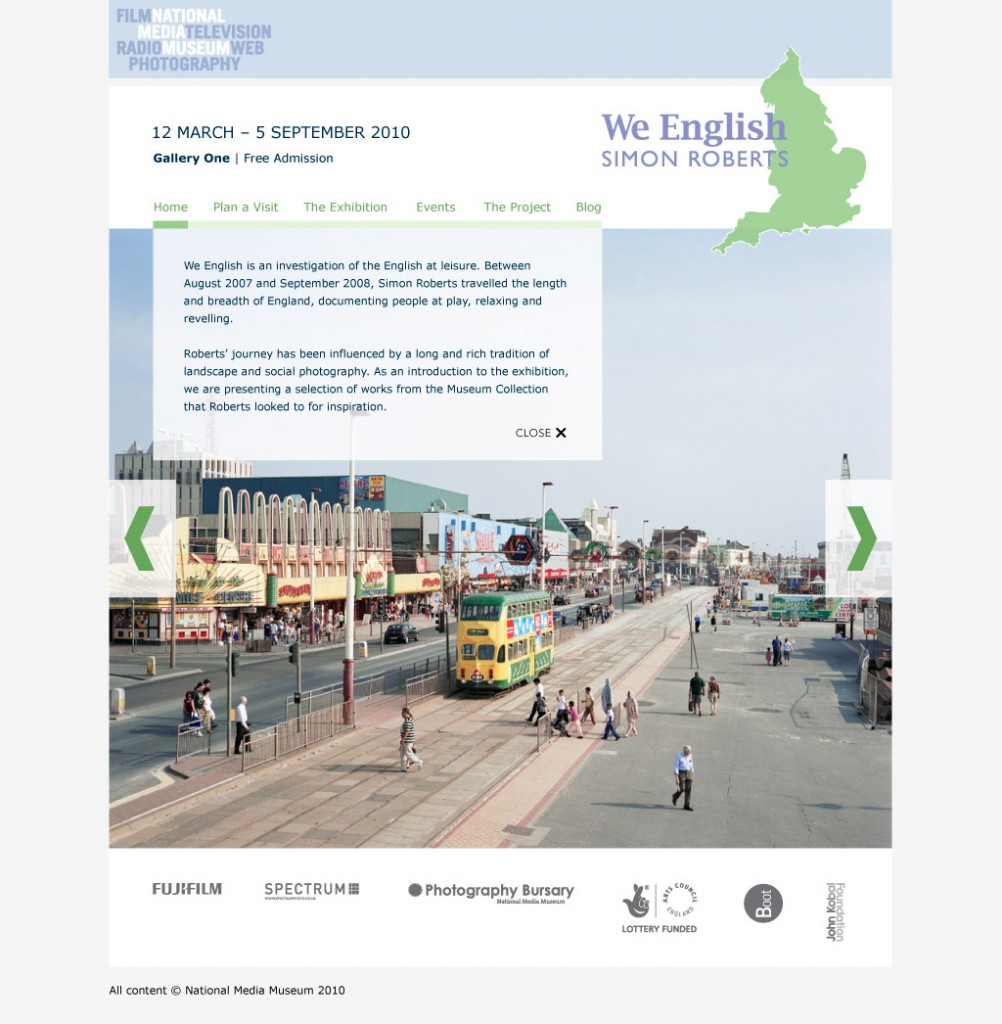
Posted in EXHIBITIONS | Comments Off on WE ENGLISH WEBSITE, MARK II
The Bradford Commission photograph, produced for my exhibition at the National Media Museum, was unveiled at the official opening of We English last night. And here it is-
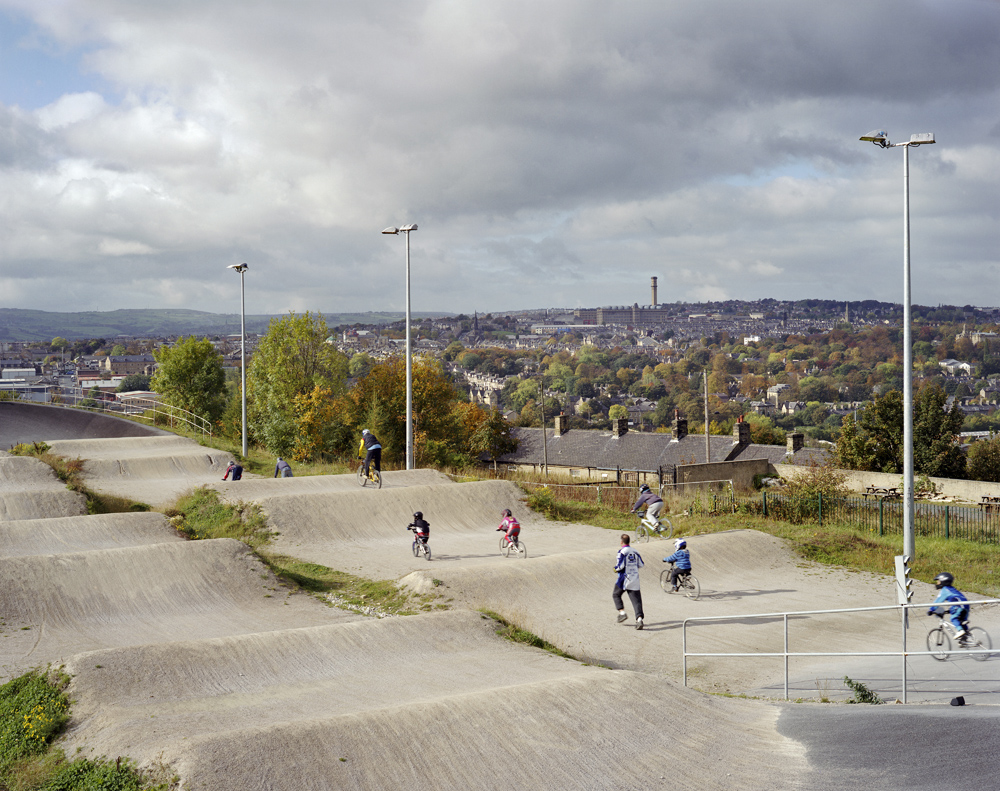
Bradford Bandits BMX Club, Peel Park, Bradford, West Yorkshire, 17th October 2009 © Simon Roberts
The photograph shows young members of the Bradford Bandits BMX Club taking part in a competition to raise funds for a local cancer charity. Bradford’s historic industrial skyline – the city rose to prominence during the 19th century as an international centre of textile manufacture, becoming known as the “wool capital of the worldâ€Â – can be seen in the distance. With Lister Mills, at one point the largest silk factory in the world, dominating the backdrop.
There is a limited edition print available, sized 11×14″ in an edition 50. Each print is signed verso and made to highest quality of Fuji Crystal Archive Paper, sleeved in an archival wallet. Priced £125 +VAT. To order, please email studio@simoncroberts.com.
Posted in THE PHOTOGRAPHS | Comments Off on BRADFORD COMMISSION PHOTOGRAPH UNVEILED
I recently asked a curator friend who they thought was one of the most important photographers working in Britain over the past twenty years, whose work has not received the recognition it deserves. The curator’s unequivocal response was Tom Wood.
Wood was born in West Ireland in 1951 and now lives in North Wales (where he moved in 2003). Much like Ian Macdonald and Graham Smith (see previous blog post), Wood has chosen to work over the past 25 years almost exclusively in a small geographical area, photographing predominantly in Merseyside and Liverpool. Working primarily on the street and in pubs and clubs, Wood photographed the public face of New Brighton (made famous by Martin Parr in his book The Last Resort), across the river from Liverpool, from the late 1970’s until he moved away in 2003. For much of his time in Merseyside, Wood worked with portraiture “ranging from refined, tonally elegant depictions to informal moments of gesture and interaction from everyday life, captured through the lens with a vision at once tender, vulgar and beautiful.” (from the press release for Wood’s exhibition of The Chelsea Reach).
The Chelsea Reach includes photographs from Wood’s Looking for Love series, taken in his local disco pub between 1984 and 1987. By the time Wood started working in the club he either knew or recognised by sight many of its clientele – some of the faces belonged to young people he had photographed on the streets years before. His observations possess a raw closeness without being voyeuristic. Here are some of his photographs from the project –

Untitled, 1982-86 from The Chelsea Reach © Tom Wood

Untitled, 1982-86 from The Chelsea Reach © Tom Wood
 Untitled, 1982-86 from The Chelsea Reach © Tom Wood
Untitled, 1982-86 from The Chelsea Reach © Tom Wood
 Untitled, 1982-86 from The Chelsea Reach © Tom Wood
Untitled, 1982-86 from The Chelsea Reach © Tom Wood

Untitled, 1982-86 from The Chelsea Reach © Tom Wood
Wood’s recent solo shows include The Museum of Photography, Copenhagen, Denmark; Foam Fotomuseum, Amsterdam; Musee de l’Elysse, Lucanne. His work can also be found in the public collections of MoMA, New York; The International Centre for Photography, New York; and the Victoria & Albert Museum, London.
There are several publications of his work, most of which are out of print: Bus Odyssey (Hatje Cantz, 2001); People (Wienand Verlag Koln, 1999); All Zones Off Peak (Dewi Lewis Publishing, 1998); Looking for Love (Cornerhouse Publications, 1989); and Photieman (Steidl, 2005).
The publishing blurb for the latter says: “For 25 years Tom Wood lived in New Brighton, just across the river Mersey from Liverpool. He became known locally as ‘photie man’ because everyday he was out on the streets with his camera. Most of the pictures collected together in this book were taken within 5 minutes walk from Wood’s home. The work focuses on the inhabitants of the town and its regular visitors, from Liverpool day-trippers to clubbers who attended the Chelsea Reach nightspot. Wood’s images are a dazzling selection of cocky youths, friends, lovers, fathers, mothers and babies that provide insight into the area, it’s inhabitants and the rites of passage inherent in growing up. Artist and curator Padraig Timoney has collaborated with Wood in the selection and sequencing of photographs to make a significant book-work.”
You can read a review of Photie Man by Ken Grant on Foto8.com here and see spreads from the book on Shane Lavalette’s blog here.
Posted in OTHER STUDIES | 10 Comments »
The other week, in the space of a couple of days, I somewhat bizarrely happened across the siblings of two British photographers in two separate circumstances – the first during a lecture I was giving at the Cleveland College of Art & Design and the second during a visit to Martin Parr’s studio in London. Interestingly both the photographers in question were born in the north east of England within a year of each other and have spent most of their photographic careers documenting the community where they grew up and lived. They have both produced historically significant bodies of work and have, to varying degrees, shunned the spot light over the years.
The photographers in questions are Ian Macdonald (b.1946, UK) and Graham Smith (born 1947, UK).
After labouring in a string of jobs in heavy industry, Ian Macdonald went on to forge a career in photography and has spent the last forty years photographing the hinterland of his native Cleveland. He has gained acclaim for his powerful studies of the industrial and post-industrial world he was born into, with its smoking chimneys, its dockyards and salt-of-the-earth people. His work examines the relationship between man and his environment, and has often focused upon the heavy industry based around the River Tees, particularly in the 1970s and 80s. His rich and extensive work includes ‘Greatham Creek’, ‘The Tees Estuary’ and, exploring the villages of the Esk Valley, ‘Quoits’ (photographs from which can be seen on the Side Gallery website here). In 1987, with the painter Len Tabner, he produced the book ‘Smith’s Dock – Shipbuilders’, exploring the later days of the construction of North Islands, the last ship to be built by this shipyard on the River Tees.
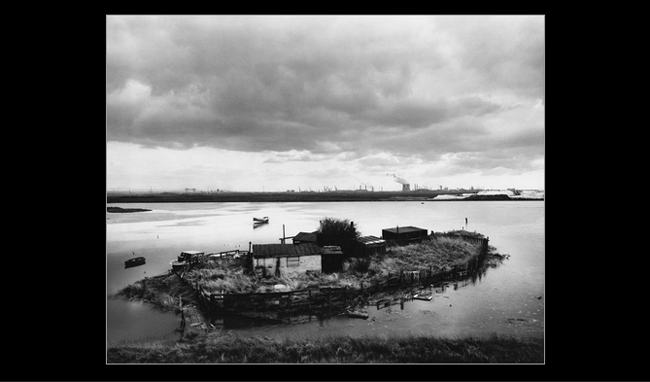 Greatham Creek © Ian Macdonald
Greatham Creek © Ian Macdonald
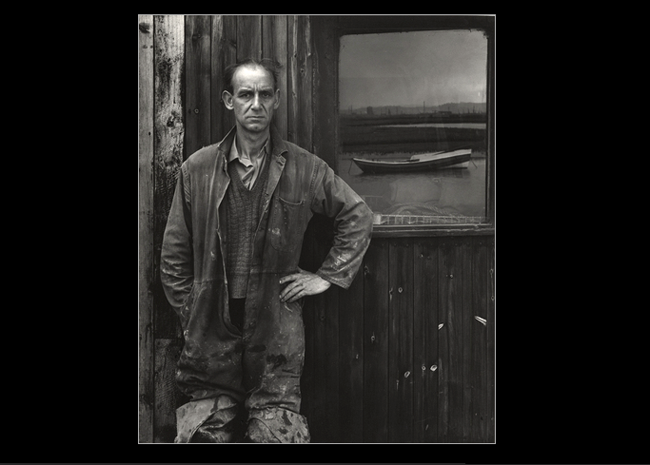
Ken Robinson © Ian Macdonald
I thought I’d let Macdonald talk about his work in his own words, with extracts taken from a speech he delivered at the Press Conference for the launch of ‘Art of Photography’ exhibition at the Royal Academy of Arts in 1989 (which is as poignant now, as it was then):
“Many of the images which photography spawns and which are common to us all are either to report an event or to sell a product. All the material we see is mechanically reproduced. We are fed it in dollops between dramatic headlines, advertisements, sport, fashion and a whole host of other things. This imagery varies in size from postage stamp to giant billboards, each designed for a particular purpose essentially to capture and hold our attention for some ulterior motive which in so many cases has little to do with the actual image. This bombardment gives the art of photography an indifferent name, the images are cropped, manipulated and mutilated which discredits the photograph. Such material, being so unavoidable, can only precondition the ways in which people look at and consider photographs.
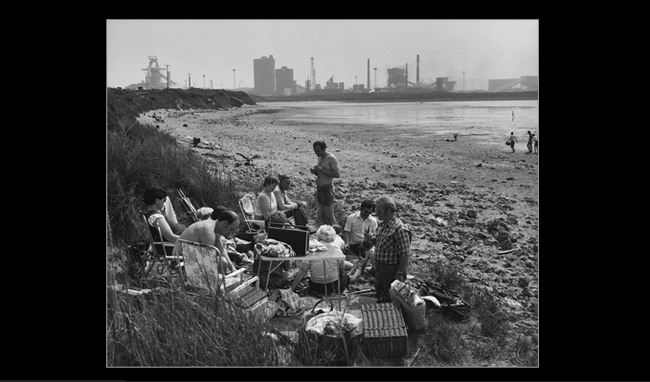
Within sight and sound of the largest blast furnace in Europe © Ian Macdonald
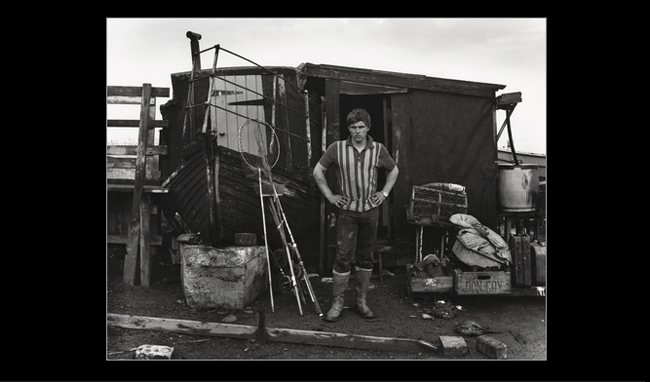
Young John Allison © Ian Macdonald
“Two of the most obvious things about photographs intrigue me, their stillness and silence; these are for me also their major strengths. Photographs, being silent and still, preclude reality other than in that most superficial sense of the representation of an apparent likeness. In precluding reality they fall into the realm of myth, where everyone is free to invent by association as they see fit, for the meaning of each photograph is conditioned by those personal experiences the onlooker takes to viewing each image. This makes many types of photograph universally accessible. It follows that it is close to impossible even to contemplate the irrelevant notion, which is, are photographs Art? As Paul Strand so succinctly stated “All painting is not art”.
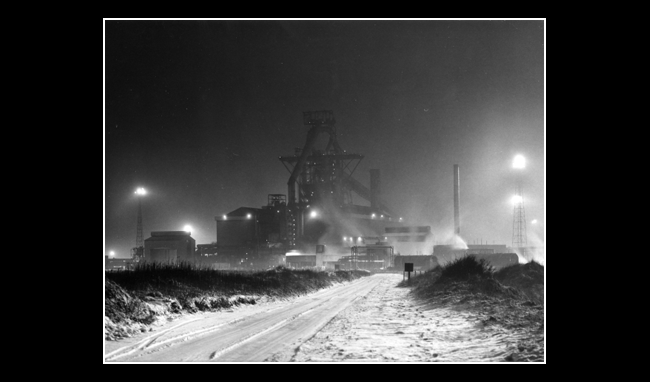 Largest blast furnace in Europe at Redcar, Teesmouth © Ian Macdonald
Largest blast furnace in Europe at Redcar, Teesmouth © Ian Macdonald
“It is the viewing of real photographs, which is singularly important. The actual photographic print, from the negative, as the artist made it is very particular. Each original print though made from one negative is, in fact, unique. The size, tone and surface of the print and not least the image, which is what it is all about, are all specific to the artist. To be of any real value it is better for the artist to have made the print. Considering photographs need to be given both time and space, and like any other “good” piece of artwork the “good” photograph will grow with viewing. It will develop, freeing the mind, as looking and reflecting will inevitably raise other notions, associations and feelings and so a process of enrichment goes on.” Read Macdonald’s full statement here.
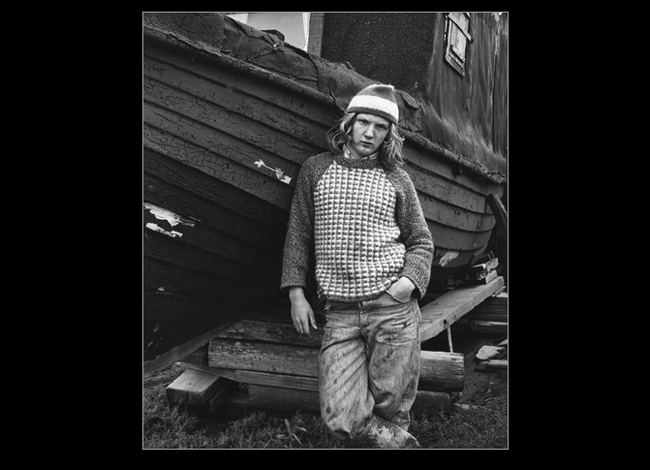 Young lad, houseboat side © Ian Macdonald
Young lad, houseboat side © Ian Macdonald
Macdonald has produced several books, most notably Eton (2007) – Between 2006-2007 he lived as part of the famous Eton College community as artist-in-residence, teaching and making a photographic response to that environment. He has also collaborated with painter Len Tabner on the publications Smith’s Dock Shipbuilders (1987) and Images of the Tees (1989). Macdonald has exhibited widely and his work features in many collections, including the Victoria and Albert Museum, London; the Arts Council of England; and the Danish Royal Library, Copenhagen.

Eton by Ian Macdonald
You can find out more about Macdonald’s work and purchase copies of his books here. Also, Macdonald’s son, Jamie, has made a film which looks at his father’s unique practices (he still process and prints his own work at home in the darkroom) and individual philosophy. As well as showing photographs from his archive, it captures the artist making new work. Martin Parr is quoted on the jacket sleeve saying “This charming film gives an insight into this process and working methods. We learn how he shoots and prints these spectacular images, using analogue technology and patience, which is so rare in our digital age.” You can purchase a copy of ‘Shooting Time’ by sending an email to mac.duncan@virgin.net.
A few days after meeting Jamie Macdonald in Darlington, I had the unexpected pleasure of meeting Graham Smith’s daughter in London. Like Macdonald, Smith photographed extensively in the north east of England and particularly in the city of Middlesbrough.
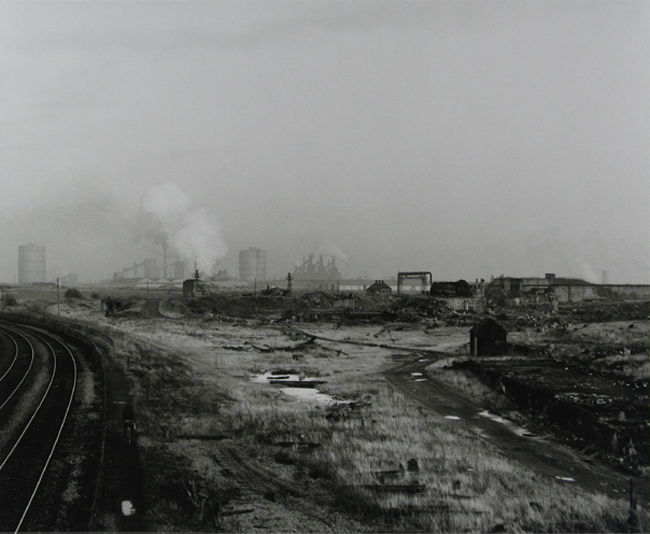 The Black Path, Middlesbrough © Graham Smith, 1986
The Black Path, Middlesbrough © Graham Smith, 1986
Smith was born into a family whose work, class and culture, on his father’s side, was rooted deeply in the heavy industry of iron making for at least four generations. His beginnings in photography came at Middlesbrough College of Art and later the Royal College of Art. From the start his subject was close to home and Smith spent more than a decade making photographs of his friends and relatives and the pubs they frequented around the South Bank area of Middlesbrough.
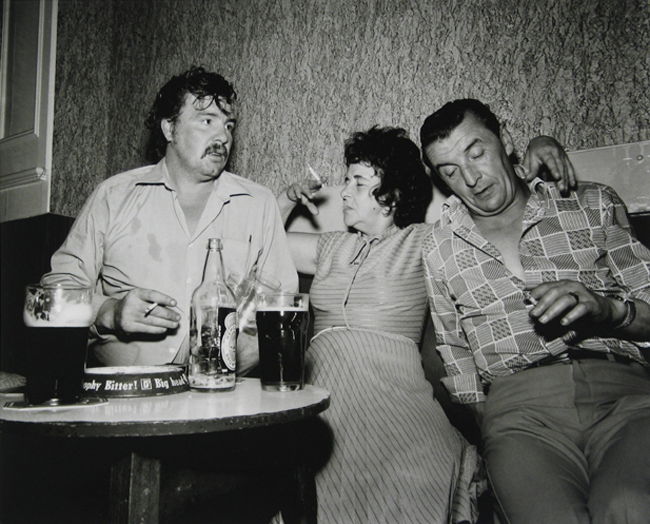 I Thought I Saw Liz Taylor and Bot Mitchum in the Back Room of the Commercial, Middlesbrough © Graham Smith, 1984
I Thought I Saw Liz Taylor and Bot Mitchum in the Back Room of the Commercial, Middlesbrough © Graham Smith, 1984
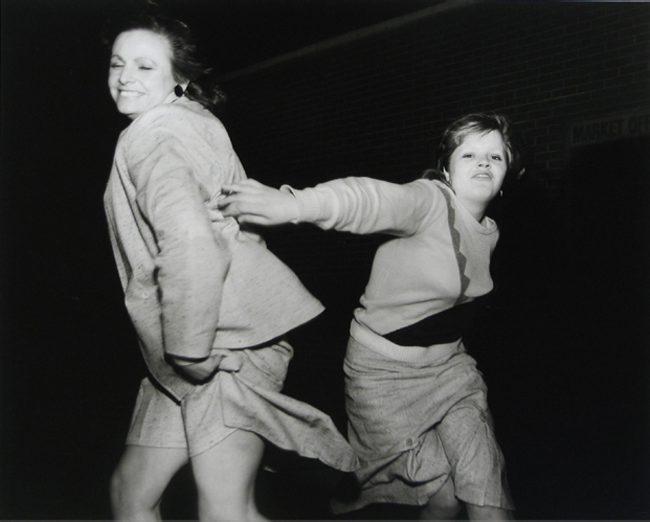
Dancing Girls, Middlesbrough © Graham Smith, 1985
In the 1970s Smith was among the photographers central to the Side Gallery in Newcastle, and created a series of photographs that showed working-class people in the north of England that were in a documentary style but were in fact montages. Work from the 1980s would show people within townscapes, and in the words of David Alan Mellor, were “atmospheric, steeped in popular (and personal) memory — dark, romantic places with all the melancholy attributed to Eugène Atget’s familiar locations”. Another Country, a joint exhibition with Chris Killip held in London at the Serpentine Gallery in 1985, was generally well reviewed but to some appeared passé in the light of the new “postmodern” work of Martin Parr and others (Killip’s work from the project became the foundation of his book, In Flagrante).
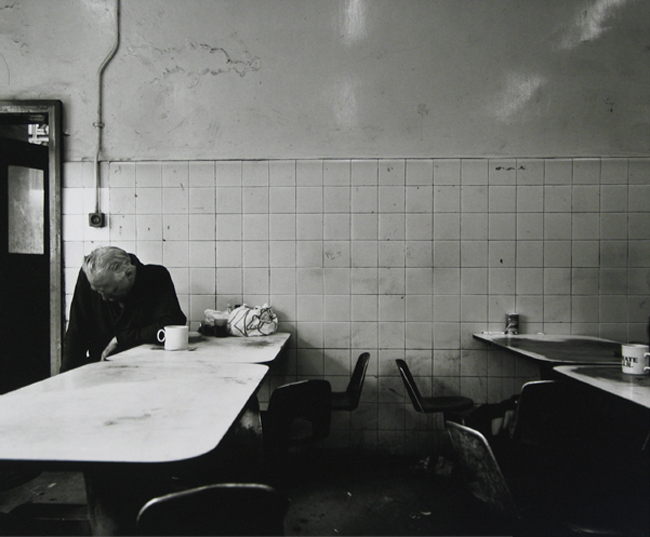 Thirty – Eight Bastard Years on the Furnace Front Mess Room for No. 4 and No. 5 Furnaces, Middlesbrough © Graham Smith, 1983
Thirty – Eight Bastard Years on the Furnace Front Mess Room for No. 4 and No. 5 Furnaces, Middlesbrough © Graham Smith, 1983
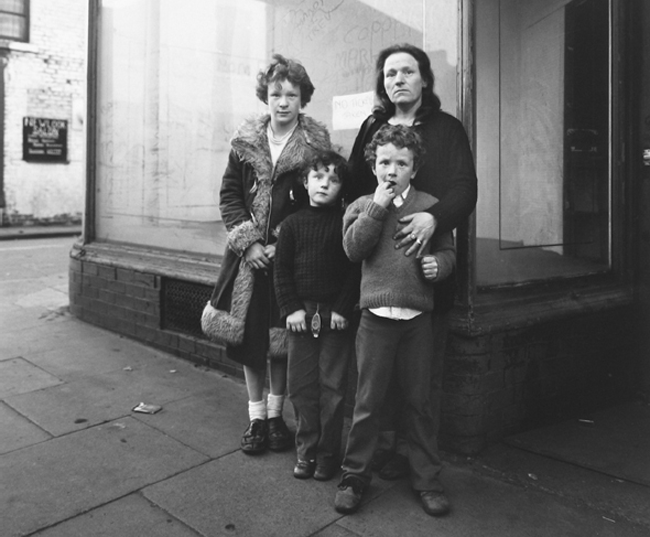 No Tickets Taken, Middlesbrough © Graham Smith, 1982
No Tickets Taken, Middlesbrough © Graham Smith, 1982
The inevitability of working for life in the iron and steelworks troubled him and disillusioned with photography, Smith stopped making photographs in 1990, when he became a professional frame maker. Although he has continued a life-long investigation of his working class roots through his research and writing. Recently his work could be seen in Granta 95: Loved Ones, published in 2006, where he wrote an essay called ‘Albert Smith’, about his father’s life:
“My dad, George Albert Newton Smith, was born into a family whose culture, work and class were rooted deep in the heavy industry of ironmaking. In hope of a better life, his great grandfather left the ironstone mines at Rosedale during the middle of the nineteenth century to look for work in the fast growing industrial town of Middlesbrough. He was the first of four generations to work for the powerful ironmasters who, with their vision of an iron and steel metropolis, built so many blast furnaces along the River Tees that it was said one man could not count them all in one day. There was a job for any man who had the strength to work and the will to give loyalty for life to the company. As a young boy older than his years my dad knew that when his days at school ended, by tradition he would follow his own dad into the Cargo Fleet Iron Company. Working together under the structure of three formidable blast furnaces, they repaired the large steam cranes used for moving ironstone and slag. His older brother Bill worked as a front man at the foot of one of those blast furnaces, but some years later was crushed to death when the ageing furnace, under too much pressure, exploded.” Graham Smith, 2006

Outside the Commercial, Middlesbrough © Graham Smith, 1982
Despite Smith’s work being held by several major collections including the Museum of Modern Art in New York, and the Victoria and Albert Museum in London, it has been almost impossible over the past twenty years to see his photographs. More recently he seems to have been coming (ever so slightly) out of the shadows with his prints now represented by Eric Franck Fine Art in London – there were some fabulous prints on show at last year’s Paris Photo – and Rose Gallery in LA.
A quote on Eric Frank’s website maybe best sums up Smith and his work – “People, pubs, stories, photographs, writing and ego have all been important to him and Smith’s photographs can be seen as an obsession to understand values, good and bad, of the culture he left behind.”
You can find out a bit more about Smith on wikipedia here.
Both Macdonald and Smith are from a generation of photographers who were driven to document the experiences of the places where they grew up and lived, charting the injustices of society but also the stoicism and richness of the characters they photographed. Neither were interested in awards and accolades, rather they wanted to tell the stories of those around them.
Posted in OTHER STUDIES | 3 Comments »
I was in Bradford yesterday helping to install the We English exhibition. It’s early days but the edit is starting to take shape (here are a few snaps from the process).
I hope to see some of you at the opening next Thursday 11th March. There’s also the ‘Breakfast with the Artist’ event at 10.30am on Friday 12th where I’ll be in conversation with curator Greg Hobson and fellow photographer, Robbie Cooper, who is exhibiting photographs from his Immersion series in the Museum’s Gallery 2.
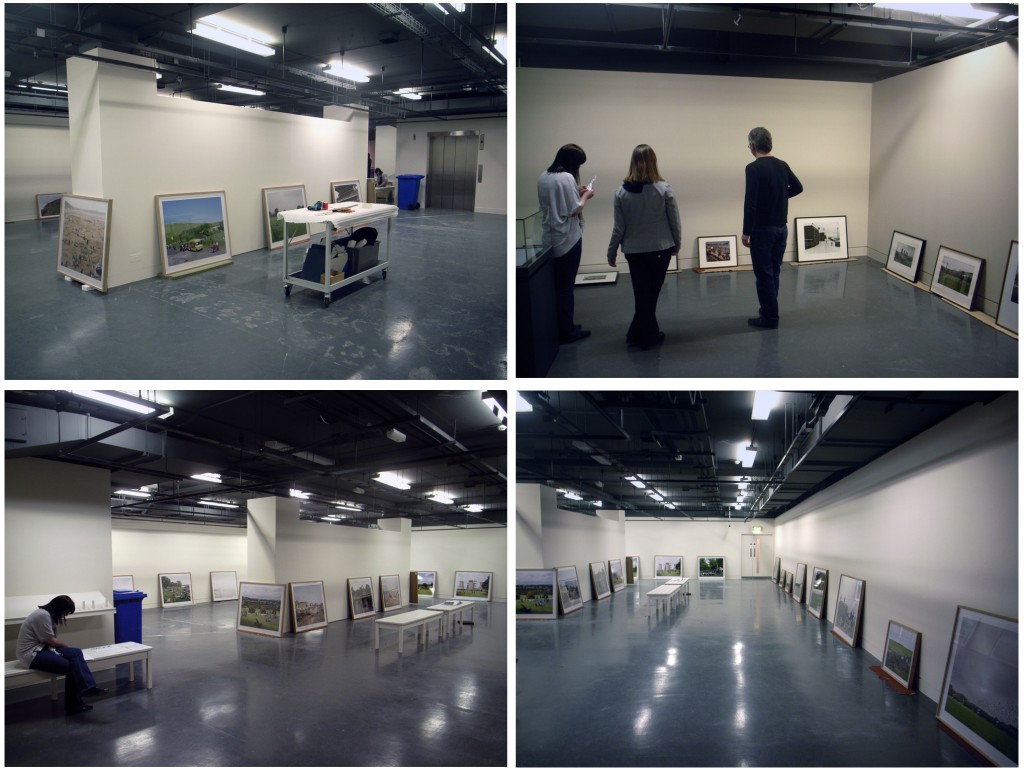
Posted in EXHIBITIONS | Comments Off on NMM EXHIBITION, PART 5
There is a review of We English in the current issue of Source (Winter 2009/2010) by Jane Fletcher under the title ‘Away from the Shopping Centre’. You can download a pdf here.
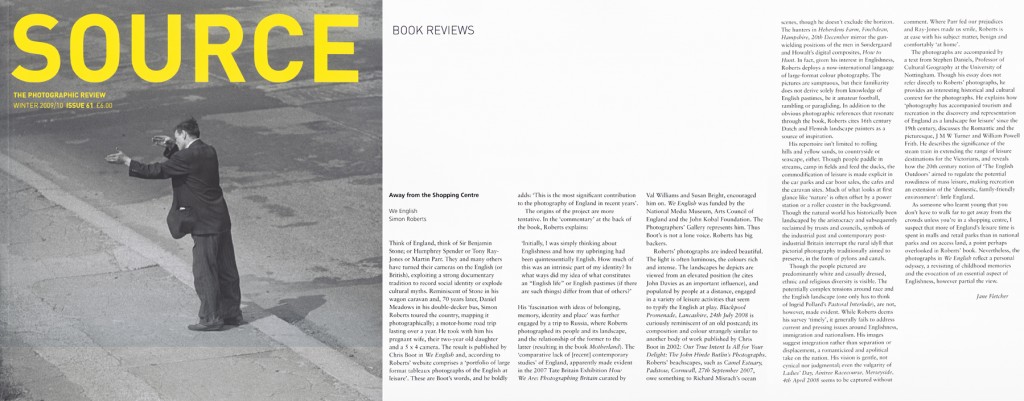
Posted in REVIEWS & PRESS | Comments Off on SOURCE MAGAZINE
 Maidstone Young Bird National Pigeon Race, Maidstone, Kent, 13th September 2008 © Simon Roberts/We English
Maidstone Young Bird National Pigeon Race, Maidstone, Kent, 13th September 2008 © Simon Roberts/We English







 Untitled, 1982-86 from The Chelsea Reach © Tom Wood
Untitled, 1982-86 from The Chelsea Reach © Tom Wood















